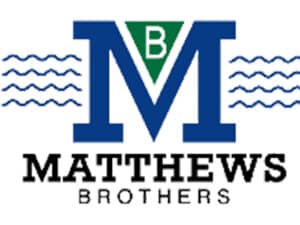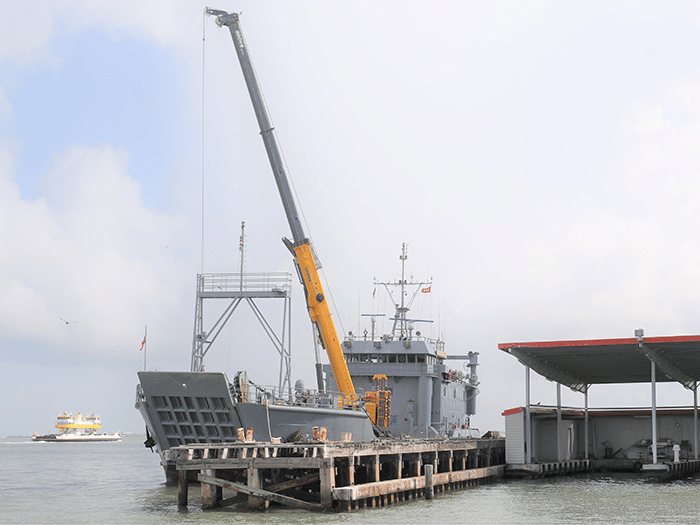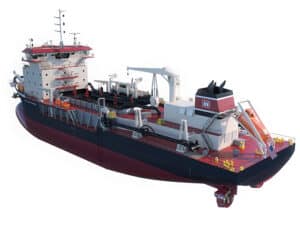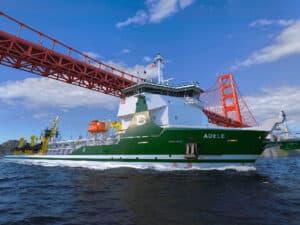
MPV Brandy Station brings added capabilities to Galveston District
Written by Heather Ervin
The Multipurpose Vessel Brandy Station shortly after arrival in Galveston with a 130-ton crane loaded on the deck. (Credit: USACE Galveston)
The Galveston Engineer District plays a key role in America’s economy by keeping waterways open for navigation and commerce. The Galveston District is directly responsible for monitoring more than 1,000 miles of channel along the Texas Gulf Coast. This navigation mission sometimes requires getting help from some friends in the Wilmington Engineer District (SAW).
A 10-person crew of Corps civilians brought the Multipurpose Vessel (MPV) Brandy Station to Galveston last week. The MPV Brandy Station will work on missions previously completed by the MPV Snell. The Snell worked in the Galveston District from 2017 to 2023.
The Brandy Station made it from Wilmington, N.C., to Galveston in seven days. Talon Smith is the captain of the ship, and the crew works 16 days on, then takes 12 days off.
Originally built as a Runnymede Class Landing Craft Utility (LCU), the vessel was originally commissioned into the U.S. Army Transportation Corps as the USAV Brandy Station (LCU-2005) in May 1990. It has has similar mission capabilities as the Snell, to include marine construction, navigation hazard removal, and clamshell and hydraulic dredging for small critical shoals in federal channels and adjacent non-federal channels. The crew performs clamshell dredging by attaching a bucket to the onboard crane. Hydraulic dredging uses pumps and pipes to move dredge material.
“We have some dredging work we’re going to be doing,” said Joen Petersen, SAW Floating Plant Chief, aboard the Brandy Station, July 24, 2023.
The MPV is also outfitted with pumps for small dredge jobs where material can be pumped 1,500 to 2,000 feet. Additionally, the Brandy Station can support maintenance and storm relief for U.S. facilities and territories and maritime transport.
“The vessel itself has a worldwide capability; about a 10,000-mile range,” Petersen said. “We carry just under 90,000 gallons of fuel. We have the capability to make our own water if we need to. The deck itself will carry 350 tons. The crane on board right now is a 135-ton crane and it has about a 200-foot reach. It replaced the old crane on here which had a 35-ton capability with an 80-foot maximum reach.”
“To put it in perspective, the Snell would fit on the deck of the Brandy Station,” Petersen said.
Upcoming projects for the Brandy Station and its’ crew include mooring maintenance and construction at the Brazos and Colorado River Locks.
“We’ll go down there and put the new buoys in,” Petersen said. “We’ll drive the subsurface anchors down to put all those in.”
The Brandy Station can also repair lock walls damaged by barge traffic, build docks and drive sheet piles. Sheet piles are steel sheets with interlocking edges which can be used to recreate retaining walls.
“The Brandy Station can also install navigation buoys,” Petersen said.
Using the crane to lift and drop a large steel beam like a hammer, the crew pounds anchors 40 feet down into the ocean or river floor, with two-and-a-half-inch chain attached to the anchor. Then the crew pulls on the chain to make sure the anchor stays put. After the pull test, mooring buoys are attached which are then used by tugs and barges.
“The Brandy Station can pound spuds (steel cylinder anchors) which enables the vessel to do construction work,” Petersen said. “The ship also has a front landing ramp, so the crane can be offloaded with relative ease for work from land.”
The Brandy Station can also help with disaster relief. The vessel was used to transport telephone poles to Puerto Rico in 2017 for Hurricane Maria relief efforts.
Onboard desalination equipment can produce 2,000 gallons or 16,000 bottles of water a day. The deck can be configured for use as a container ship, which can carry up to 30 shipping containers.




